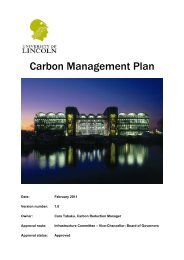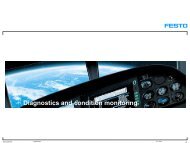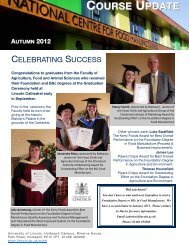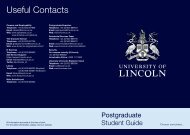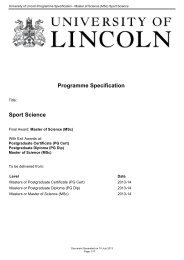LSA Magazine Issue 2 (PDF) - University of Lincoln
LSA Magazine Issue 2 (PDF) - University of Lincoln
LSA Magazine Issue 2 (PDF) - University of Lincoln
- No tags were found...
You also want an ePaper? Increase the reach of your titles
YUMPU automatically turns print PDFs into web optimized ePapers that Google loves.
ResearchPostgraduate STUDYSustainabilitySustainability in the built environment has beenhijacked in recent years by prefixes <strong>of</strong> ‘green’,‘intelligent’, ‘smart’ and ‘eco’. Smart cities,eco-towns and intelligent or green buildingshave all been exposed as exercises <strong>of</strong> buildingbrand image rather than building a secure andsustainable future.MSc Master IN SustainableArchitectural DesignSustainability has been one <strong>of</strong> the majortopics <strong>of</strong> debate since Rio declarationin 1992. According to the UnitedNations (1997) sustainable developmentthat which ‘meets the needs <strong>of</strong> thepresent without compromising theability <strong>of</strong> future generations to meettheir own needs’. Over the past fewyears, however, there has been arising interest within the internationalcommunity in introducing sustainabilityin education at all levels. In response,the <strong>Lincoln</strong> School <strong>of</strong> Architecture, asan important centre <strong>of</strong> research andlearning in the built environment withinthe <strong>University</strong> <strong>of</strong> <strong>Lincoln</strong>, aims to playa key role in preparing future decisionmakers to meet the challenges <strong>of</strong>sustainable development by <strong>of</strong>feringa specialised postgraduate course inbuilding design; the MSc in SustainableArchitectural Design.16These ‘empty signifiers’ have obscuredthe urgency with which buildings andcities need to reduce their dependencyon energy and consequent greenhousegas emissions in the process <strong>of</strong> lighting,heating and cooling buildings and cities.Add to this our dependence on oil fortransportation and it is easy to seewhy the production <strong>of</strong> buildings andcities is unsustainable unless thereis radical change.There have been some importantadvances in the last 40 years witha gradual evolution from ‘energyefficiency’ to ‘passive design’ and nowthe ‘regenerative design’ <strong>of</strong> buildings.Buildings and cities are getting better butnew buildings are not replacing the oldat a pace that will make any significantdifference within the short period <strong>of</strong> timeleft before the ecological disaster, causedby climate change, and the economicdisaster caused by resource depletion.To try and tackle this, a new area <strong>of</strong>research is now emerging that focuseson decentralising and decarbonisingenergy supplies to cities. Measuring andmapping both energy and carbon on anurban scale is beginning to reveal thepotential for autonomous urban energysystems. Every city differs in its energysupply mix, its energy demands andconsequent carbon emissions.For example, Sydney, Australia, producesall its electricity from coal and theenergy demand problem is buildings inthe city centre and their dependencyon air-conditioning. An audit <strong>of</strong> energydemand resulted in a ‘carbon map’that has led to a phased programme<strong>of</strong> generating electricity inside the cityusing decentralised gas fired generatorsthat not only produce electricity but alsochilled water for cooling buildings withsignificantly less carbon emissions.Another example is Auckland (NewZealand), a city designed around theautomobile. The problem there is notcarbon from electricity generation, butcarbon from transportation. Researchinto the potential <strong>of</strong> using ro<strong>of</strong>topphotovoltaics to power electric vehicleshas resulted in a ‘solar potential map’.The ro<strong>of</strong>s <strong>of</strong> the city can not only supplyelectricity for all transportation needs butalso provide an excess for the grid.Researching energy supply issues in thisway is proving a far more effective way <strong>of</strong>reducing carbon emissions than tacklinga city one building at a time. This as anarea for collaborative research betweenengineers, economists, planners andarchitects which are all areas <strong>of</strong> expertisein the <strong>University</strong> <strong>of</strong> <strong>Lincoln</strong>.Written by Pr<strong>of</strong>essor Hugh Byrd,<strong>Lincoln</strong> School <strong>of</strong> ArchitectureINTERNATIONALARCHITECTURE IN AN EVOLVING WORLDThe <strong>Lincoln</strong> School <strong>of</strong> Architecture,in collaboration with IBEX, presentedits 2013 annual International SummerSchool in July <strong>of</strong> this year. Over thelast two years this event has attractedmore than 250 students from 15countries. The theme for this yearSummer School was ‘Architecture inan Evolving World’.The focus <strong>of</strong> the summer schoolthis year was on low carbondesign; cultural and environmentalsustainability in the context <strong>of</strong>globalisation, and was delivered overtwo weeks in a combination <strong>of</strong> lecturesfrom academics and guest speakers,seminars, field trips, and studioprojects.Students explored the themes <strong>of</strong>:❚❚❚❚❚❚Low Carbon CommunitiesZero energy design and renewableenergyIntegrated Building InformationModelling (BIM)Study field trips and tours included avisit to London and York, as well asto local sustainable projects such asnearby Hill Holt Wood, which includeda hands-on build project for studentgroups. A colourful social event wasalso held inside <strong>Lincoln</strong> Cathedral.A certificate <strong>of</strong> attendanceacknowledging the students’engagement with the course ispresented to all those that completethe summer school.17




